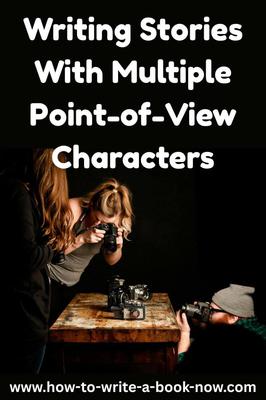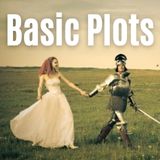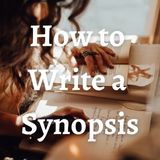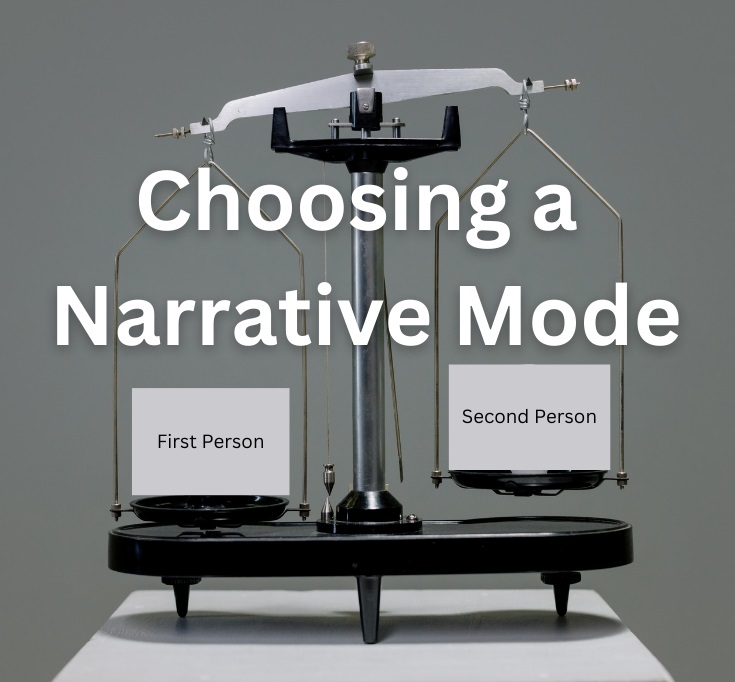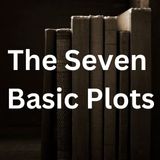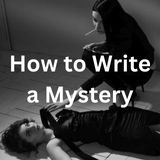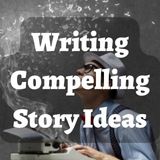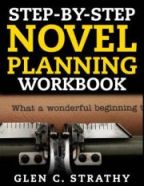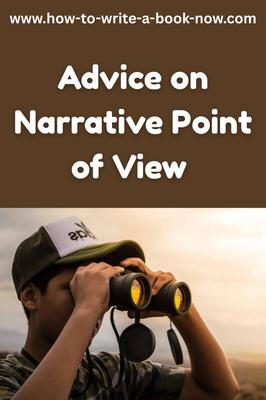Single POV vs multiple POV's
by Fredrik
(Oslo, Norway)
I've been thinking a lot about how to angle this question. This will be long. Keep in mind that this is just my opinion.
It seems like every time someone comes to you with a question and mentions that their story includes multiple POV characters, you never fail to add in your reply that having multiple POV characters comes with a trade-off. Something along the lines of books contain a finite number of pages and the more POV characters you have the less time the reader gets to spend with the main character and connect with them and watch them develop.
This is all very sensible. A balanced position. But I get the impression that you prefer a single POV, at least in principle. I was wondering if you could give some examples where one would work better than the other and vice versa. Both in theory and actual examples. I have some examples of my own.
In general I think a single POV is best for short stories and stand alone novels. For longer novels (400+ pages) and book series I think multiple POV's work better. I find that single narrators tend to overstay their welcome if I spend too much time with them. For several reasons. I won't bother listing them all, but the main ones are that I grow tired of their voice, and having one narrator restricts where the story might go and ultimately makes the story a bit too predictable, especially in a book series.
There are many examples of great stand alone novels with a single narrator. But I think most people would grow sick of these voices if stuck with them for too long. I think listening to Holden Caulfield nagging about phonies for another 200+ pages would quickly grow tiresome.
I think that's part of the reason why book series with a single narrator tend to have really bland, Mary Sue-like main characters. Characters need flaws to be interesting, but if we don't get breaks from those flaws then they become annoying. I have never read a book series with a single narrator that I would describe as "great". I dare say the highest one might come is "really good", as is the case with the Harry Potter books. But Harry as a character is really bland. It's everything else that makes it a good series, though the world building could have been better, and would have been better if we could have seen it from other points of view. Seeing the same things from different perspectives is what makes characters, objects and worlds really come to life.
I think getting a break from characters in longer works is really important. Distance makes the heart grow fonder, familiarity breeds contempt, that sort of thing. Having multiple narrators carrying the story gives them room to be more human without the reader getting tired of their personalities.
Response Thank you for putting so much thought into this question. (Unfortunately, I had to edit part of your question because 10,000 words is the limit for a page.)
I wouldn't even try to give a definitive answer, because I don't think one is possible on this issue. But here are a few thoughts...
First, it is true that creating a character who the reader will want to stay with for a long time is challenging. Writers can also get tired of their characters, which is often why they create new characters. Agatha Christie, for example, grew to hate Hercule Poirot and preferred to write Miss Marple stories. But Poirot certainly paid a lot of bills.
It's also harder to create a character that a wide readership can relate to without making them a little bland or generic. Distinct characters often appeal to fewer readers.
I think you also have a point about "Mary-Sue" characters. But let's remember that the term, Mary-Sue, doesn't necessarily mean a bland character. The term originated in fan fiction, where a Mary-Sue is form of writer's wish-fulfillment. The phenomenon occurs when a writer puts a version of herself into a fictional world. Usually, the Mary-Sue is an ideal version of the writer, or a version that lets her fulfill her personal fantasies about being in that world. Hence, a Mary-Sue in fan fiction is almost always the smartest character in the room.
I think some of the more popular characters in genre fiction have a touch of Mary-Sue about them, simply because there's a level on which every character represents a facet
Of course, you can make a mistake and write a series about a character that is so one-dimensional that you grow less interested in him/her. In that case, the readers might get less interested as well. Changing POV characters may be as much about the writer getting bored with a character and sensing the reader might a break too.
However, I don't think it's necessarily true that readers grow tired of a long-running main character. Some will and they are the ones who stop buying the sequels. However, in a genre like Mystery, readers often keep reading a lengthy series because they like following the life of the main character through various adventures and stages of his/her life. Often, the more time a reader invests in a character, the more they want to keep reading stories about that character. (This is what makes a long-running series successful.) The character becomes an old friend to the reader.
But, to the point of your question...
I have said a few times that you don't need more than one main character, which is true and a part of Dramatica theory. However, there are times when you might want multiple POV characters. For example...
1. In Romance, it is very common to tell the story from the perspective of both romantic leads, because the reader wants to know what the male lead is thinking to know he is the right mate for the female lead.
2. To create dramatic irony, in which the reader knows something the main character does not. For instance, in Suspense it is common to provide a little of the villain's point of view so that the reader sees the trap that is being set for the main character, even though the main character remains oblivious for most of the book.
3. To provide a more objective look at the story problem. For instance, in Literary Fiction, you don't necessarily want the reader to identify strongly with a character but to look critically at the characters and the world they live in. Multiple POV characters give the reader a broader, more comprehensive, and more detached perspective on the story world.
4. If you are writing a multi-generational epic, you probably need to change POV characters as people die. Note that these kinds of epics are like Literary Fiction in that they offer the reader an objective view of a family or culture over a span of generations. The reader can then consider issues or patterns that can only be seen over a long time frame.
5. A similar case can be made in historical fiction, where you are educating the reader on history as well as entertaining. For instance, if you are describing a political struggle, you might have a different POV character from each faction so the reader gets an intimate look at the motivations of all parties and see that they all have valid perspectives. Thus, the reader is challenged to say who is right. You can do the same in fantasy stories that also feature political struggles.
6. Sometimes multiple POV characters are a way to draw in different types of readers. For instance, if you think you have several different archetypal readers you want to appeal to, you may create a character each of them can identify with. (You see this more in children's or YA fiction.)
I don't prefer single over multiple POV characters. But I will say it is simpler to plot a single POV, so I think beginning writers should consider why they want to use multiple POVs before they make that choice.
I think the key point is that you have to know what readership you are writing for. Different choices create different kinds of emotional or intellectual experiences for the reader.
Some readers prefer a strong emotional connection with one character and would be bored by a more objective perspective. They may also prefer a story that creates an emotional response, such as fear, adrenaline, or love. They may prefer page turners to thought-provokers.
Other readers enjoy an objective perspective that makes them think about themes, issues, and ideas. These readers may reject a purely emotional adventure for its lack of intellectual stimulation.
And there are plenty of combinations and grey areas.
Comments for Single POV vs multiple POV's
|
||
|
||
Multiple Points of View
Question:
I have a series planned in my head and am planning to write the story from multiple points of view (POV) -- from 3 characters' POV, actually. The problem is I don't want to switch back and forth every chapter or every 2 chapters. Is it normal for a book with multiple POVs to have 1 character speak for 5 chapters then another for maybe only 2? To keep some mystery 1 of the characters wouldn't be able to have a POV for a good chunk of the book in the beginning. Later on it could switch more consistently though.
Answer:
I see no problem with what you are planning to do.
You are free to spend as much or as little time with any POV character as you choose, so long as it serves the story. You certainly don't have to switch every chapter or at regular intervals. Being completely predictable is not an asset.
You also don't have to develop your POV characters equally. You may have one as the main character and others as secondary, or any other arrangement that works.
Every story is different and must be told in the way that is best for that story. That's all that really matters in the end.
Best of luck.
multiple first person POV or third person POV
by chynna
(philippines)
Hi. I'm currently stuck right now of what POV to use. My original idea was like a diary of events that happened with the couple (the main characters), narrated by their group of friends. It's a love story actually and written in past tense, so technically, these characters already knew everything that happened, what they're doing is just like they're compiling all the events..
Which POV would be best to use here? I'm quite having a problem since I love the personalized feel of the first person, but since we're talking about a group of friends here, I'm afraid I might confuse the readers on who's narrating..unless I use the pronoun "we"?
Or would it be possible to mix the first and third person?
Or do you have any suggestions on how I can write it in multiple first person POV effectively?
Thank you~
Answer: It sounds like what you want to write is an Epistolary novel, which is a novel that consists of a series of letters, often written back and forth between a small circle of people. Each letter tells part of the story.
This is a multiple POV technique, and you would identify the writer of each letter so the reader knows whose POV they are in at any given time. The writer of each letter will naturally use first person when referring to themselves and second person when addressing the person they're writing to. They will also switch to third person when telling the story of a past event.
These friends could be writing to each other in order to piece together the history of this relationship, with each person filling someone in on events that only they know about.
The classic novel of this type is Clarissa, an 18th century book by Samuel Richardson about an abduction of a young upper class woman.
The challenge is that, in addition to the history of the relationship, you will create the sequence in which various people write to each other to make their contribution - so the process of piecing together the past becomes a storyline in itself.
Comments for multiple first person POV or third person POV
|
||
|
||
|
||
|
||
|
||
|
||
|
||
Help with antagonist's goals and using multiple POVs.
Question: Wondering if anyone with great wisdom can help me...
I have 2 problems really that have pretty much stopped me writing anything decent for a few weeks. I'm on my first ever novel and have no experience with writing apart from trawling the internet for advice and articles.
1) I feel my story will span over a few books because there is so much to tell. So I don't really want to "present" my antagonist until near the end of the first novel. Instead she tricks another character into doing her bidding as the world she wants to take control of is protected from her, but only for now.
However, as I write I'm finding the antagonist's story goal less than intriguing and if I'm honest very samey and cliché in comparison to so many other stories: She wants to destroy the institution for what happened to her as a child as payback. Now, one of the MCs will ironically share this passion to destroy the status quo, or at least part of it after what she goes through herself so I think that's a decent link there. However, the antag has to murder the last living heir in order to take full control of a state that has wronged her so she can run it better.
2) This is the "In over my head" part: I have a good few characters who are geographically separated throughout the story. I have been writing the chapters as multiple POV's (Every chapter sees a diff POV - like GRRMartin) I'm just wondering if this is ridiculous to try and manage for my first ever book?
I have no prior writing experience but now that I've been mulling this over for over two years, writing bits here and there, it's like I owe it to the book and myself to finish it now. There's no question, I have to finish it.
I really don't think I can write it any other way other than using multiple POVs. It seems to be working fine up until the point where I suddenly realized my antagonist's goals started to feel flat and boring. (See point 1 above) I want her to be feared tremendously, with an air of mystery what with not been seen in years etc. and I don't want to write her POV as to give away what she is thinking etc but there are at least five to six other characters that are or will be linked together. This seems like a good sign to me although they are not linked together by the antagonist but will turn out to be.
So I suppose my two questions boil down to: Is there possibly a way to spice up my antagonist's goal? I have her backstory tucked away in the corner of my brain somewhere but I think revenge has just been done to death at this stage or am I being too hard on myself?
And
Am I being completely crazy to attempt multiple POVs on my first novel?
If anyone has any advice I'd really appreciate it.
Thank you very much!!
Answer:
First, regarding the use of multiple POV characters, keep in mind that each POV character is the hero of his/her own story.
Often it helps to map out a timeline for each person's story. You want to make sure you have a clear dramatic arc for each character's storyline. The basic pattern for a dramatic arc being...
1. Setup/initial approach: Show who they are at the beginning of the story, how they handle problems, etc. before the events of the overall story have a chance to pressure them.
2. Complication/Growth: Show how tackling the challenges of the story pressure them to change, consider a different approach, doubt themselves, etc.
3. Move to Crisis: Show how the character is forced into a position where they must decide whether to double down on their old approach or take a leap of faith and try a different approach.
4. Judgement: Show whether the character made the right choice by how they ended up. Are they happier, more at peace, better off, etc. or not at the end of the story.
You might also have a timeline for the external events of the story -- the actions of the villain and other characters and reactions to those deeds.
The process of braiding these separate storylines into one complete timeline will give you an outline for your story that can guide the writing process and help you spot ahead of time where any plot problems may lie.
Especially, look for places where the various story lines will merge (most likely at the crisis, but other crossovers may occur).
As for whether you should use multiple POV characters, you have to ask yourself what contribution each character's perspective makes to the story. If a character's contribution is not necessary, it might be better to omit it.
A trade-off exists in which having more POV characters provides the reader with a broader perspective but less intimate connection with the main character. On the other hand, fewer POV characters (or just one) provides a more intimate experience but a narrower perspective. You have to decide what's best for your story.
Finally, it helps if you can give each of your POV characters a distinct and appealing voice.
As for the question of your antagonist seeking revenge...
Yes, revenge is an old (or perhaps tried-and-true) motivation for a villain. I think the trick for making it authentic is to make it specific.
It is the specific details of your character, her life, and her personality that create authenticity. Make her story and her need for revenge specific and unique to her. A villain appears to be a cartoon when the writer fails to make her unique and simply relies on cliches as a shortcut.
Best of luck.
Problems Weaving Multiple Plotlines
by Hamza
(Adelaide, Australia)
Dear Glen,
I am writing a story about a suicidal young mortician who talks to the dead in his head. He gets conned by his boss, a guru like character, into loving life again.
I have really good stories for the dead people that talk to the younger mortician, but they are stories leading up to their death where they meet the young mortician.
How can I weave the dead people's stories into the young morticians' without allowing them to take him off the stage as a protagonist?
Or would it be more appropriate to write an ensemble piece showing each of the dead people as a POV character in their own story, but when dead and in the presence of the mortician, use them as impact or supporting characters?
Thanks for all your immense help.
Response: Honestly, you could do it either way, but there are questions to be answered first.
You will need to decide who is the real impact character. Is it the boss or the ensemble of dead voices? What is the goal? And who is the real antagonist?
Is this a story of how the young man's life is saved from his obsession with death? What effect do these dead voices have on him? Are they feeding his worst impulses or are they trying to save him?
What decision will he make at the climax, and will it be the right one? That will determine the message of your story.
After that, you have lots of leeway to decide the balance between the main character's and the ghosts' stories. You can choose according to what is most interesting to you and the reader.
You can have the young man's story as a bare frame to hold essentially an anthology of tales that may have a common theme, or you can make the book all about him with just enough of the ghosts' stories for them to play a role in his life.
I can't tell you what's more appropriate because this is something that all depends you and how you execute your ideas. You have to follow your instincts.
More About Multiple Points of View
by Dunn
(Nashville)
Question I am writing a Sci Fi Fantasy type novel and I'm hoping you'll say more about multiple points of view. Most of my ideas for my novel are in 1st person, present and seem to really work like that. However, there are some scenes that need to take place in another part of the Universe away from my main character. I was thinking about switching to omniscient for those scenes. But I see that when you talk Multiple POV, you say it must be either third person, limited, or first person. Why not omniscient?
Answer: You're quite right. There's no rule that says you can't switch to omniscient for those moments. It's simply that omniscient has become less popular in recent decades.
We can speculate on why. Omniscient gives readers the experience of being able to understand the big picture of what's going on in the story world. It's about looking at the characters from an outside perspective, like a king or god.
Omniscient was popular for most of history when the average person, even an educated person, had a very limited understanding of the world outside their immediate community. Only rulers looked at people objectively, so they could manipulate them. Sociology, psychology, economics, and the other social sciences were fascinating fields when they emerged because they offered people new insights into the invisible forces that shaped the human world.
Today, thanks to mass media and especially the internet, it is easy for people to get bombarded with too much information--much of it contradictory, biased, and unreliable. "Personal reality" at the expense of objective truth seems to offer security to many people, no matter how inaccurate their resulting beliefs may be.
So now the subjective experience seems to be more desired in fiction. First person and third person limited have become the dominant forms of narration.
One also comes across a lot of books that offer a kind of hybrid: narration via multiple points-of-view.
Multiple POV books tell the story through a variety of subjective experiences. The reader gets to pretend to be a number of diverse characters. Sometimes each POV is intensely personal. However, the consequence of assuming so many viewpoints is that, at the end of the book, when the readers step back and consider the whole of what has been read, they are forced to take a more objective stance--as they must with omniscient narration. It's like going through a process of repeated associative-disassociative experiences, or like a series of relationship break-ups.
Now, what you're proposing is probably less jarring. If you're just doing a few scenes in omniscient, the effect may be like a having an occasional withdrawal from the subjective experience of being the main character in order to gain a wider perspective on the story or to create dramatic irony.
The interesting thing to consider is not just what information or events the reader may learn about in those moments, but what they might reveal about the main character.
It also raises the question of who your omniscient narrator is and what voice they will use. (Many readers won't care, but a few may find the switch annoying.)
You just have to trust your instincts, and possibly your critique partners.
Comments for More About Multiple Points of View
|
||
|
||
|
||
|
||
|
||
|
||
|
||
Writing in multiple points of view
by Marissa
Question: I never know if I should write in first or third person. I always want to do first but I'm not always sure if it would work especially when there's multiple POVs. I've seen books written in first person but they multiple POVs but it's always only 2 people no more like the book Legend it has 2 main characters that tell the story and switches of every chapter and it's told in first person just like the Kane chronicles. But then there are books like The Mortal Instruments or Heroes of Olympus that have multiple POVs but it's in third person and they always have more than 2 characters telling the story. The only book series I've read with multiple POVs and in first person is the I am Number Four series because it's told from most of the characters and it's always in first person.
So my question is, is it ok to write in first person with multiple characters POVs? I know it would be ok with 2 characters but would it be ok with 4 or 5? I want to write a book with the POV from 4 of the characters who are the main characters and they're all separate but eventually come together and are working toward the same story and I wanted to have each POV in first person. Is that ok to do? I just wonder because I haven't seen many books with multiple POV that were in first person they're all in third and the only one I can think of that's not is I am Number Four. Is there problems with multiple POVs in first person? Will readers be confused? Or will I be ok and it will totally work for me?
Answer: There's no rule about these things. You have to decide for yourself what is right for your story, and sometimes you won't know until you've written some of it and can see how it feels.
I believe the first use of multiple POV in first person was the epistolary novel, which is a type of novel told in the form of letters. For example, the classic novel Clarissa, written by Samuel Richardson in 1748, features half a dozen or so characters writing letters back and forth to each other, each person telling part of the story, and each person writing (naturally) from his/her own point of view.
Some things you need to consider are...
* It's important not to confuse the reader regarding whose point of view they are in. It helps if each POV character has a unique voice and if you include a few clues after each switch to orient the reader. It's also best to only switch POV characters at chapter breaks.
* Every POV character essentially becomes the main character of his/her own story, but not all their stories need to be fully or equally developed.
* Bear in mind that the more POV characters you have, the less of an intimate connection the reader experiences with any one character. The effect is to move your story closer to an objective or omniscient perspective. In other words, if you are going to sacrifice some of the connection that a single POV character offers by using multiple POVs, make sure your choice will add something of greater value to the story.
* Usually a story is more effective with one main character whose inner conflict leads to the resolution of the overall story. A common variation is to have one main character with a few minor POV characters to create dramatic irony (where the reader learns things the main character doesn't).
Although multiple POVs is usually a weaker choice, it can be the only way to tell multi-generational stories or epics. It is also sometimes done in YA an attempt to appeal to readers with a broad range of personalities -- to give each reader someone they can relate to better. Whether this strategy is works is debatable.
But as I said, these are not rules and there are plenty of exceptions.
Comments for Writing in multiple points of view
|
||
|
||
|
||
Multiple Points of View
by Dana Michaels
(California)
Question: I've been told I'm "head-hopping" in my contemporary romance manuscript. How do you convey different characters' thoughts, feelings, or reactions to others (or events) without changing POV?
For example, two people getting to know each other often notice each other's mannerisms and characteristics at the same time (i.e., over dinner). Is it really bad writing to express his thoughts in one paragraph followed by her thoughts in the next? What is the proper way to let a reader know what both characters are thinking or feeling?
Even worse, if she is meeting his family over dinner, where three or four people - whose future actions will affect the relationship - are sizing her up, what is the correct way to let readers know their thoughts?
Thank you.
Answer: The simple answer is that if you are using limited narration -- which means you are writing from one character's POV -- you cannot write about another character's thoughts and feelings. The reason is obvious: your POV character has no idea what other people are thinking or feeling. And in limited narration, you only narrate what the POV character perceives, thinks, and feels.
What you should do is have your POV character observe other characters actions and reactions. Have her note their actions, statements, facial expressions, tone of voice, etc. Then she might infer or guess what they may be thinking and feeling. However, just as in real life, your main character may easily be wrong about what's going on in other people's heads.
Bear in mind that if you provide your POV character's observations about what other characters do, say, etc., the reader will also infer what is going on in everyone else's head. The reader can be just as wrong, but that's part of the game.
Of course, there are exceptions...
One approach often used in romance is to use multiple POV characters. However, you should not change points of view or mix points of view within a scene. Readers like to know whose POV they are occupying in each scene and it is confusing when they think they are in one person's head and suddenly find themselves hearing another character's thoughts.
Head hopping destroys the reader's illusion that she is inside the POV character's head, which is where the intimate connection between reader and character comes from. The illusion is what helps the reader imagine she is the main character.
So write the scene from one POV. But later, in a chapter told from a different character's POV, you can have the second character remember that scene differently. You can convey their thoughts after the fact.
Another approach is to use omniscient narration, but this comes at a cost of a lot of intimacy since it gives the reader the feeling of looking at all the characters from a distance instead of being the main character.
Standard practice in romance is to use two POV characters: the two romantic leads.
Best of luck.
- Home
- Writing Questions
- Multiple Points of View
